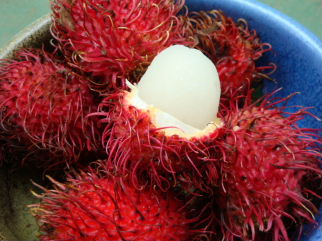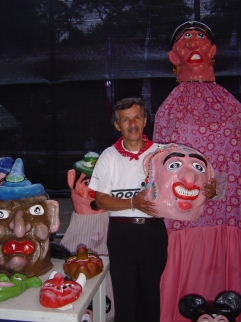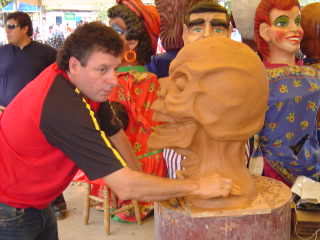|
|||||||||||||||
|
|
|||||||||||||||
|
Jan Yatsko, Artist email: For those people who wish to contact me through email, please see the note on my Contact Page. |
|||||||||||||||
 |
|
Take a peek into artist Jan Yatsko’s daily life in Costa Rica. Humor, reflection and inspiration are woven into her experiences that revolve around her passion for art, nature, culture and food. NOTE: I am writing a book based on my Pura Vida observations. Readers will be able to travel along with me while I teach them how to record their experiences in a self-guided travel art journal. Stay tuned! |
|
Dancing Giants November 2009 18th edition “None are so old as those who have outlived enthusiasm.” ~Henry David Thoreau Over 15 years ago on one of our bicycling vacations in Costa Rica, Tom and I rolled into the western port town of Puntarenas. Our plans were to relax after 6 hours of bicycling, but instead we found the ambience of the town electrified with the sights and sounds of its annual carnival. Tempting aromas of new food to eat mixed with salty sea breezes and hustlers from the games of chance beckoned the public to try their luck. The people who lined the street moved their hips to the parade of percussion bands that played infectious Latin rhythms; however the public became more animated when the mascaradas (giant masked dancers) appeared. Giant masked woman with a breast size to match, devils, policemen, skulls, prominent politicians, witches and figures from old Costa Rican legends danced down the street cajoling the public until they squealed with delight or fright. |
|
|
||||||||||||||||||||||||||||||||
|
The roots of present day Costa Rican mascaradas came from the religious festivals and carnivals of medieval Spain. The masks were made of enormous proportions that made the wearer look like a dwarf and the masked people paraded in the street with comical and ridiculous movements. During the 1560’s, the town of Cartago was the first to be colonized by the Spanish and with that came the giant masked figures brought by the Franciscan missionaries and priests. To this day, Cartago is considered the cradle of mascaradas followed by the towns of Barva de Heredia and Escazú. Several years ago, Tom and I purchased our own mask, the Medusa, from Manuel Mena. Manuel told me that it was his young son’s fear of masks that prompted him to take his first mask making class 25 years ago. His reason was that if his son saw how they were made, his fear would dissapate. More recent masks are made from fiber glass, but the traditional ones are still made from paper maché. Each mask begins with the figure sculpted in clay followed by 8 layers of various papers mixed with white glue. When the last outer layer is dry, the clay is removed and the mask continues to dry in the sun for a week. The character of the mask becomes apparent when it is painted, varnished and attired. Mascaradas energize the public during carnivals, festivals for a town’s patron saint and at ox cart parades. They are always accompanied by a cimarrona band which consists of a hodge podge of musicians playing horns and drums. To see a mascarada and cimarrona warming up before a parade click on the following: http://www.youtube.com/watch?v=NX9lKhzAAOU Copyright Jan Yatsko November 2009
|
|
A 100% Costa Rican Experience |
|
Spend a day in Escazú at a traditional and colorful ox cart parade and witness first hand the energy of the giant masked dancers accompanied by the cimarrona band. Join a small group of curious people in March 2010 who share a common desire to Explore & Create in Costa Rica. Rub elbows with native Costa Ricans as you experience their culture, art, nature and food. “This trip satisfied my desires in the most unexpected and delightful of ways. It provides a wealth of opportunity for those who choose to appreciate its gifts.” Nancy B., an Explore & Create in Costa Rica tour participant. To find out more about what Nancy experienced, travel to the Explore & Create in Costa Rica page of this website. |
|||||||
|
So what was that red fruit?! |
|||||||
 |
|||||||
|
The answer to the September newsletter name that fruit contest is “mamon chino” in Costa Rica, “rambutan” in Indonesia and “lychee” in Asian restaurants in the USA. Mamon chinos grow on trees and the white fleshy fruit is revealed when you peel away the soft red skin. It has a refreshing, light and juicy flavor. Catherine G. from Pennsylvania won a framed painting by me for being the first to correctly answer the question. To quote Catherine, “I have never seen a mamon chino, but I have learned a lot just researching. I would love to taste one! Even if I don’t win, I’ve already won the best consolation prize in learning something new from your web log. Thanks for sharing your discoveries of Costa Rica with us “States-bound’.” I decided to do this contest for fun and to give something of value to my readers. To my surprise many of you commented how much you enjoyed reading my newsletters for the past three years. I received a prize, too! Thank you! |
|||||||









